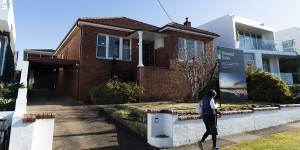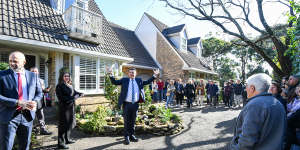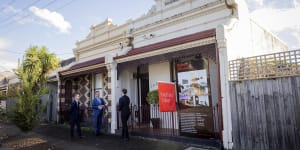Home values nationally jumped 382 per cent over the past 30 years,and about 72 per cent in the decade to July,CoreLogic figures show. However,homeowners banking on similar future gains could be left disappointed.

Home values nationally jumped 382 per cent over the past 30 years.Rhett Wyman
Melbourne recorded the largest jump over the past three decades. The median value rose 459 per cent,or 5.9 per cent per annum in annual compounding terms,and prices in some inner suburbs increased more than 700 per cent.
It was followed by Sydney (449 per cent) and Hobart (399 per cent);prices in both these cities almost doubled over the past 10 years. This eclipsed Melbourne in the past decade,when prices in the Victorian capital rose only 69 per cent.
Regional Tasmania was the only market where prices more than doubled over the past ten years,increasing 104 per cent. Perth and Darwin had similar gains the previous decade.
CoreLogic research director Tim Lawless said Melbourne had benefited from more consistent price growth than Sydney over the three decades,due to stronger population growth and comparatively milder affordability challenges.

Meanwhile,Sydney’s price growth had been fuelled by population growth,higher levels of investor activity and an undersupply of housing. Hobart’s property prices had been playing catch up after years of being undervalued,as population growth ramped up over the past decade.
Dwelling values in most cities climbed at least 5 per cent per annum,on average. Perth was the exception at 4.8 per cent. Prices across regional Australia increased 4.7 per cent per annum.
House values rose substantially more than unit values in most regions.
“Most[cities] were seeing an annual growth rate between 5 and 6 per cent,” Lawless said,adding this dispelled the long-held housing myth that property prices doubled every 10 years.
The median house price in Australia has risen by $1000 a day in the last year.
There were six cycles of price growth and decline across the national index over three decades,Lawless said,depending on taxation policy,monetary policy decisions,economic shocks,fiscal stimulus and broader economic conditions. There were also substantial differences between regions.
Melbourne’s Yarra statistical region,covering suburbs such as Fitzroy,Carlton North and Richmond,recorded the strongest growth as values rose 779 per cent. It was followed by Melbourne City (760 per cent),the Gungahlin region in the ACT (754 per cent),and Melbourne’s Boroondara (734 per cent) and Maribyrnong (710 per cent) regions.
Selling agent Nick West,a director at Nelson Alexander,said the demographics of areas like Fitzroy and Carlton North had changed over his 33 years in the market. A sharp rise in cashed-up downsizers moving to the area,and more young families staying put there,had increased buyer demand.
“There’s no doubt that the Baby Boomer demographic has contributed to price growth,and a lot were downsizing ... and able to spend 10 to 20 per cent more to secure the right home,” he said.

Sydney’s median property price has climbed from almost $222,000 in 1991 to about $1.38 million today.Peter Rae
More home renovations over the decades,and the gentrification of high streets had also affected prices.
Pockets of Sydney’s eastern suburbs and inner west,and inner Brisbane also made the top 20.
Inner and coastal suburbs largely had the strongest growth,Lawless said. While the premium market led market upswing and downturns,blue chip properties tended to have stronger growth over time.

Values across some inner Melbourne suburbs have jumped more than 700 per cent over the past three decades.Paul Jeffers
Going forward,he expected price declines to level out as interest rates hit their ceiling,and then grow as rates reduced. He noted the longest downturn across the combined capitals since the early 1980s,lasted 21 months.
Forecasting how the market would track over the next decade would be a hopeless exercise,he added. While average annual growth of 5 to 6 per cent could continue,there could be significant volatility.
AMP Capital chief economist Dr Shane Oliver said market downturns over the 30-year period had been largely brief and mild – price falls of less than 10 per cent. Prices had then been quick to rebound as interest rates typically resumed their long-term downtrend,while demand had been buoyed by strong population growth since the mid-2000s.
“I suspect that this time it may be a bit different,” Oliver said. “It will take longer for prices to get to new record highs again,and to recover from the slump we’re now seeing.
“We’re seeing a cyclical downturn combining with the likely end of the long-term upswing that’s been underway for much of the past 30 years,which will lead to a deeper downswing and slower recovery.”
Oliver expected slower price gains over the next decade,as the cash rate and fixed mortgage rates were unlikely to return to the lows that fuelled price growth. Very high debt to income and price-to-income ratios,increasing focus from banking regulators on risky lending,and community concern about poor affordability,could also limit price growth more than in previous cycles.
Oliver has forecast capital city property prices to fall 15 to 20 per cent from peak-to-trough,on the assumption the cash rate lifts to 2.6 per cent. Prices could then start to recover in the second half of next year,when the Reserve Bank may look to cut rates. However,if rates rose higher,there could be larger price falls.
The Market Recap newsletter is a wrap of the day’s trading..